A9 Dualling: Luncarty to Pass of Birnam - AOC Archaeology Leaflet
Transport Scotland commissioned AOC Archaeology Group to undertake archaeological investigations in advance of the dualling of the A9 between Luncarty and the Pass of Birnam. In 2018, the archaeologists uncovered evidence of human activity over the past 6000 years, during the Neolithic, Iron Age and medieval periods.
View the leaflet in PDF format




Glimpsing the Neolithic
Evidence of Neolithic occupation included pits containing broken pottery and stone tools.
The archaeologists discovered over 500 pieces of pottery, including an important collection of heavily decorated handmade pottery known as Grooved Ware. Patterns created with fingertips and fingernails bring us closer to the Neolithic potters, who left little traces of their touch on every vessel.
Analysis of residues absorbed by the pottery showed that several of the vessels were used for cooking. Some were used only for processing dairy products such as milk, butter or cheese, while others were used for both dairy and meat. The presence of dairy products highlights how diets changed in the Neolithic with the adoption of farming, as people relied more on resources from their crops and livestock rather than hunting, gathering and fishing.
The archaeologists discovered 22 sherds from the same pot, enough to know what it would have looked like when it was complete.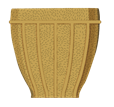

The pits also contained tools made from flint, quartz, carnelian and chert: sharp cutting tools for preparing foodstuffs, and scrapers for processing animal skins. Much of the stone used was available locally, but some came from Cumbria and Yorkshire.
This kite-shaped leaf arrowhead was buried alongside a sherd of pottery, perhaps during a ceremony.

This broken stone axehead is made from Langdale tuff, a desirable blue stone from the Lake District that was brought to Scotland through trade.

Medieval Crops
Evidence of early medieval activity in the area included traces of a small grain kiln dating to the 5th century AD. The kiln was heated by a fire. Grain was spread over a rack inside the structure, drying in the heat so that it could be stored without spoiling. Most of the grains found in the kiln were barley, and a few oats.
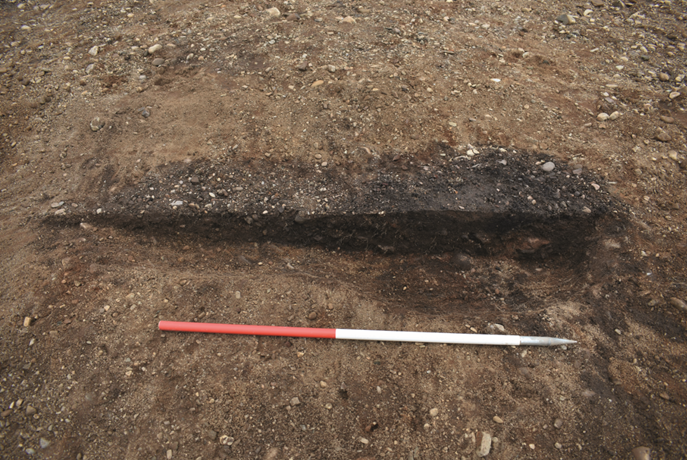 The pear-shaped outline of a kiln for drying grain. The side nearest the camera has already been excavated.
The pear-shaped outline of a kiln for drying grain. The side nearest the camera has already been excavated.
Traces of an Iron Age Community
The archaeologists uncovered evidence of two Iron Age roundhouses and one or perhaps two underground storage chambers known as souterrains. At this time, buildings were mostly circular in plan. People lived in extended family groups, farming to produce food. They grew crops including wheat, oats and barley, and kept animals: cattle, sheep/goats and pigs.
The illustration below is based on evidence from the Luncarty to Pass of Birnam excavations, and shows the site of a settlement in the Iron Age.
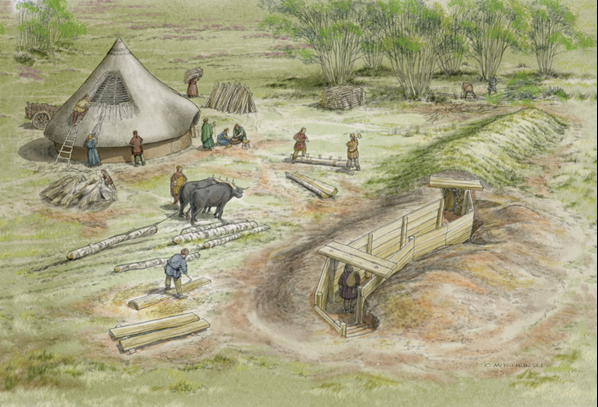
Illustration by Chris Mitchell
The Home
Postholes - pits that once held large wooden posts - show where there was once a roundhouse. Traces of a second roundhouse overlapping the first suggest that it was replaced by another building on almost the same footprint.
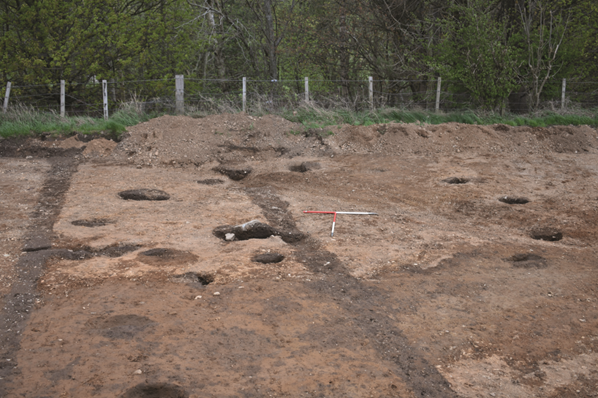
A ring of postholes marks the location of upright posts for a roundhouse
Repairing the Thatch
Evidence from other sites shows that some roundhouses had thatched roofs. Experimental archaeology suggests that, with regular maintenance, a thatched roof could last for decades.
Storing Supplies
This is a souterrain, an underground passage or chamber. It was possibly lined with planks, and it may have been roofed with timber and covered with earth or turf. We don’t know exactly what souterrains were for, but they may have been for food storage, like an underground larder.
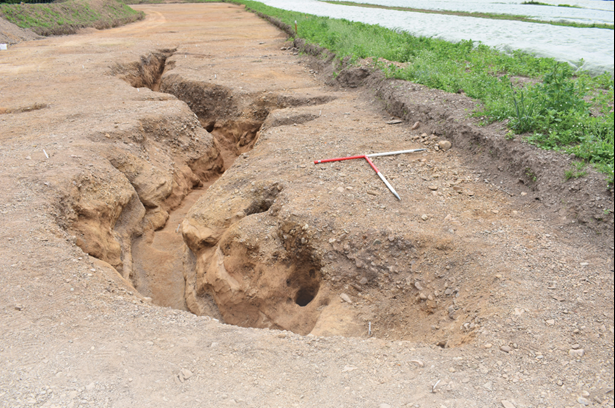
This souterrain was probably used as an underground storage chamber
Working Wood
Fragments of burnt wood from the souterrain suggest that the builders had shaped the wood into planks.
Grinding Grain
Oats, barley and wheat were discovered during the excavations. We know from finds at other Iron Age sites that quern stones were used to grind grain into flour.
A tiny blue glass bead, less than 5mm across, gives a glimpse of Iron Age fashion. It may have been made by recycling broken glass.

Neolithic (4100 BC-2500 BC)
- First farmers
- Standing stones
- Stone circles
- Burial monuments
- Beaker pottery
Bronze Age (2500 BC-800 BC)
- Roundhouses
- Standing stones
- Stone circles
- First metals
Iron Age (800 BC-AD 400)
- Roundhouses
- Hillforts brochs
- Iron technologies
- Roman presence, AD 70s-AD 210s
Medieval (AD 400-AD 1500)
- Christianity
- Picts and Vikings
- Emergence of Scottish nation burghs
- Chapels
- Castles